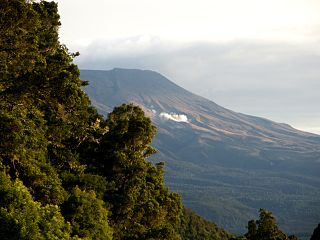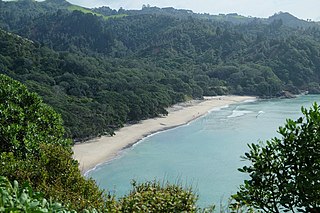
Waihi is a town in Hauraki District in the North Island of New Zealand, especially notable for its history as a gold mine town.

Western Bay of Plenty District is a territorial district within the Bay of Plenty Region of New Zealand. The district envelops Tauranga City by land, and includes Matakana Island, at the entrance to Tauranga Harbour.

Waihi Beach is a coastal town at the western end of the Bay of Plenty in New Zealand's North Island. It lies 10 kilometres to the east of the town of Waihi, at the foot of the Coromandel Peninsula. The main beach is 10 kilometres long. The town had a permanent population of 2,760 as of June 2022.
The Waihi miners' strike was a major strike action in 1912 by gold miners in the New Zealand town of Waihi. It is widely regarded as the most significant industrial action in the history of New Zealand's labour movement. It resulted in one striker being killed, one of only two deaths in industrial actions in New Zealand.

Whiritoa is a small beach town on the Coromandel Peninsula, New Zealand between Whangamatā and Waihi Beach. It has a permanent population in the low hundreds, which swells to over a thousand during the New Year holiday period.

New Zealand has a large number of hot springs, known as waiariki in Māori. Many of them are used for therapeutic purposes.
The following lists events that happened during 1979 in New Zealand.

The Goldfields Railway is a heritage railway that operates between Waihi and Waikino in the Bay of Plenty region of New Zealand's North Island. It operates over a section of track that was part of the East Coast Main Trunk Railway until the Kaimai Tunnel deviation made it redundant in 1978. The Goldfields Railway was formed in 1980 as the Goldfields Steam Train Society to retain a portion of the old mainline and switched to its current name in the mid-nineties.
The Bay of Plenty Times is the regional daily paper for the Bay of Plenty area, including Tauranga, in the North Island of New Zealand.
Ohinemuri is a former New Zealand parliamentary electorate. It existed from 1896 to 1928, and was represented by five Members of Parliament.

The Martha Mine is a gold mine in the New Zealand town of Waihi. Since July 2015 it has been owned by Australian-based OceanaGold.

Pauanui Aerodrome is a small aerodrome located in the middle of the Pauanui Beach township on the Coromandel Peninsula of the North Island of New Zealand.
Matakana is a former New Zealand parliamentary electorate in the Thames-Coromandel District, which existed for one parliamentary term from 1993 to 1996, and was held by Graeme Lee. In 1994, Lee defected from the National Party to the Christian Democrat Party.
Waihi College is a co-educational secondary school located in the North Island town of Waihi in New Zealand. The school motto reads in Latin 'Lex Nostra Fides' translated into English as 'Our Faith Is The Law'. It was established as a District High School in 1932. It then became a Forms 3–7 College in 1954. It moved to its current site in 1959. In 1976 it extended its roll to cover forms 1 and 2. Forms 1-7 are now known as years 7-13. Today Waihi College houses nearly 750 students during a school Calendar.
Tereingaornis moisleyi, also referred to as Moisley's penguin, is a genus and species of extinct penguin from the Middle Pliocene of New Zealand. It was slightly smaller than the extant Fiordland crested penguin. It was described by Ron Scarlett in 1983 from fossil material found by William Moisley near Te Reinga Falls on the Wairoa River, in the Hawke's Bay Region of the North Island. Another specimen was found later at Waihi Beach, Hawera, on the South Taranaki Bight. The genus name Tereingaornis combines the name of the type locality with the Greek ornis ("bird"); the specific epithet honours the discoverer of the fossil.
The Coromandel Gold Rushes on the Coromandel Peninsula and around the nearby towns of Thames and Waihi in New Zealand in the nineteenth century were moderately successful. Traces of gold were found about 1842. A small find was made near Coromandel in 1852; and a larger find in August 1867 when there was a modest rush. But Thames acquired a reputation for speculative holding of unworked ground despite regulations designed to check it, and some miners left for Queensland. Most of the gold was in quartz reefs rather than in more accessible alluvial deposits and had to be recovered from underground mines and extracted using stamping batteries.
The Waihi Daily Telegraph was a newspaper published in Waikato, New Zealand. It was published from 1901 to 1951. It replaced the Waihi Chronicle.
The Waihi Fault Zone is a seismically active area of the central North Island of New Zealand whose earthquakes have been associated with significant loss of life.

Waiau is a rural locality in the Western Bay of Plenty District of New Zealand. It is on the northern side of Tauranga Harbour, and is east and north from Waihi Beach and east of Athenree. Waiau River and State Highway 2 run through it.









